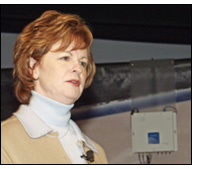It was a cold and snowy morning in New York City, but hundreds of retailers from around the world crowded into the National Retail Federation trade show’s main speaker hall to see presentations by the CIOs of three retailers leading the adoption of radio frequency identification (RFID) technology: Linda Dillman of Wal-Mart, Zygmunt Mierdorf of Metro and Colin Cobain of Tesco. All three cautioned that RFID would take time to be deployed successfully.
Dillman said RFID readers have been deployed in 104 Wal-Mart stores, 36 Sam’s Clubs and three distribution centers. She said the company had deployed 14,000 pieces of hardware and run 230 miles of cable. So far, Wal-Mart has received 7,161 tagged pallets and 210,390 tagged cases and had recorded 1.5 million EPC reads.
She said that 57 suppliers were live with the technology as of last week and that the number of suppliers shipping tagged pallets and cases would increase by the end of the month.
Dillman indicated that the read rates on items coming into the three distribution centers were not as high as Wal-Mart would like, but she said RFID is a “journey” and that it would take time for retailers and suppliers to learn how to deploy it successfully and for RFID equipment vendors to improve their products.
Tesco’s Cobain and Metro’s Mierdorf also stressed that their RFID deployments would not happen over night. Both men said that their companies were working with suppliers to roll the technology out when standardized hardware becomes available and as the business case warrants it.
Mierdorf did a live demonstration of the technology, communicating via videoconference with Metro’s RFID Innovation Center, which the company opened in Neuss-Norf, Germany, last July (see Metro Launches RFID Test Center). Staff in the center demonstrated a pallet of goods being read as it went through a portal reader. In a mockup of a retail store, a woman showed how RFID tags could be read in a changing room and how the ID of the clothing item could be used to call up related items and accessories on a video monitor.
The woman showed how the RFID tag could sound an alarm if she tried to leave the “store” without paying, how it could be used at the point of sale to call up the item on the register and, finally, how it could be removed.
Mierdorf stressed that Metro’s vision was to use RFID within its supply chain from the time goods are manufactured until the time they are sold, but he stressed that the vision would take years to reach fruition. “We are at the very beginning of the journey,” he said.


